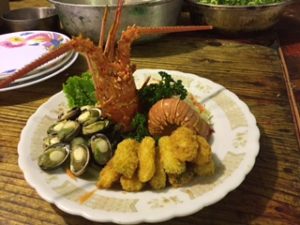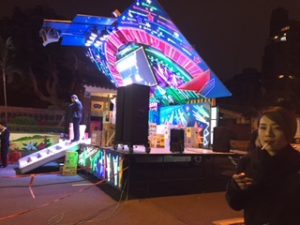18 January 2017 Wednesday
Taipei, Taiwan
Today, on the way to the street market, we passed a restaurant with a Polynesian-Aboriginal theme. So busy looking at the curious carved wooden statues, we forgot to check the menu. We also passed the house in which Loretta was born and where she grew up. Now rented, it is the older style architecture of Taipei. I say “older” because construction sites and new buildings are fast pushing out anything less than recent. An elegant Japanese-syle office was one of the more attractive new buildings we saw.
Then, we passed a local temple, the house of the god that protects the community and which was clearly enjoying good support from its community. Organized religion is alive and well in China. Many shrines and temples are to be seen, and many practitioners are visiting with offerings and bowing with hands in prayer. To the right of this local temple was a furnace (you can see the smokestack in the second photo) for burning the Hell Money, the imitation currency that is manufactured and sold for use at funerals or in ceremonies of ancestor worship. When the Hell Money is burned, the money goes to the spirit world for use by the deceased.
Just a little before and to the left of the local temple was a recycling store. Large plastic bags stuffed to overflowing with unusable extras surrounded one small Chinese man, who appearing to be sorting it all, but so slowly that I should think he shortly will be buried in it before he is done. Too bad all that stuff cannot be burned and sent to the spirit world for their use before the world of the living is buried in it.
Come Spring Festival, many of the streets are taken over by small vendors. The street markets are decorated with lines of colorful small flags stretched overhead. Everything anyone could ever want and every kind of local food is available. Everyone is preparing for the New Year celebration, and everyone is shopping. Walking through the street market is not for those who are distressed by crowds. Walking is walked at the pace of the rest of the walkers, shoulder to shoulder, elbow to elbow.
In the middle of the path of the marching shoppers, in a self-made circle,was the only beggar I have seen, a woman displaying deformed legs, a picture straight out of nineteenth-century China, who lay down on the macadam – a brave act – or sat up, by turns, and who was never trodden on.
In the street market we were walking through,were both temples and shrines. A very large market space was dedicated to the God of the City, whose bright gold statue sat between Fu Dogs. Before the City God smaller statue (a much larger statue was in an area behind) was a table laden with sugar-laden candies and sugar-laden packaged items. China’s sugar intake must be rising, for you know that all those packaged items are primarily sugar, whether in China, which historically was not a sugar consumer, or America.
The Temple of the City God has become a Temple of Matchmaking. where young people go when seeking a spouse, so this temple was crowded with younger couples and apparently single people making an offering. Many were standing before the table of offerings, head bowed in devotion. Of course, the City God would encourage matchmaking, which leads to babies, which leads to an expanded economy.
Near the temple of the City God was a small colorful shrine with many flowers and offerings, which Loretta said was a shrine of the local merchants. Such are a common site within markets.
Near the shrine of the local merchants was a shop that sold decorations and objects for worship in temples. Huge masks, bold and scary, for processions and ceremonies; large, vivid red hangings embroidered with bright gold, everything red and gold and oversized. In America, decorations for Christmas and New Year’s are red and gold, but also white and silver and blue and even green. The singularity of the Chinese New Year color scheme leaves no room for concern over which color to choose.
On a happier note, the merchants, probably those of the small shrine, were having a banquet. Round tables with red cloths and silver ware filled a cordoned-off side street. At the far end of the table-filled area, the jazzed-up stage hardly needed live entertainment, so flamboyant was its lighting display. We inadvertently walked through the kitchen area where the first course was being put together on large white serving plates: a scooped out lobster or lobster-like crustacean, its antenna yet waving midair, its meat piled in front of the carapace. These words may squelch the appetite, but the put-together plate presented a mouth-watering dish of food.
Finally, overwhelmed with noise and crowds, we entered a newly remodeled building, now an elegant art gallery, selling pottery fine china, and prints. The modern and the antique were combined, as is the fashion in expensive interior design, and on display was an old stone rice grinder for making rice flour. On the other side of the skylight well, hanging plants and vines drifted down the three-story wall On the second floor was an elegant tea room, but we passed on the opportunity to enjoy its cushioned comforts and the ten-dollar-per-person a cup of tea, rare though it was.
Stores were dark by the time we headed for the hotel, but not too dark to see an unusual juxtaposition: between two stores selling expensive women‘s clothes was a store selling bathroom plumbing fixtures, the toilet prominently featured in the forefront..
The view from hotel window at night glowed with the multicolored lights of the city of Taipei, a city that does, in fact ,sleep.



